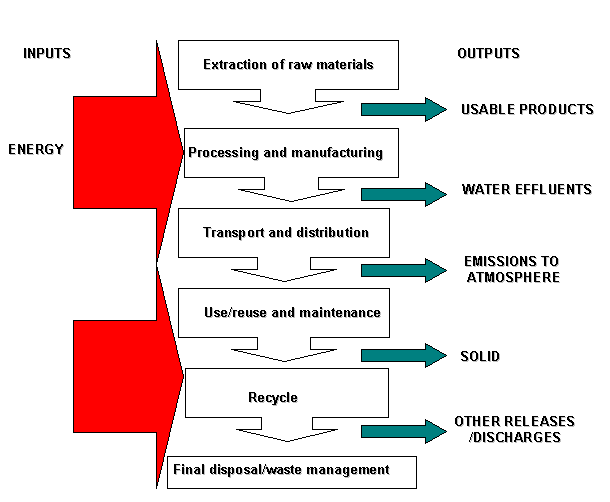|
|

|

|
Improvement StrategiesIntroduction EIP's and the setting of environmental objectives and targets must take into consideration all environmental effects. The following units will focus on examples of strategies that can be employed in the minimising of these effects and hence, in the improvement of a company's environmental performance through the ability of it to meet its objectives and targets. This will give you ideas on how to practically implement strategies within your organisation.
Example Improvement Strategies: Design StrategiesProduct based assessments When looking at the environmental impact of a company's product it is important to look at the design of the product itself and the means by which design considerations may improve environmental performance, should these be seen as significant. Life Cycle Assessment (LCA) The assessment of a product's life cycle can have a significant bearing upon the current and future design of a product. Undertaking LCA can aid in design considerations and minimise environmental harm caused at any stage of the product's life cycle and also, identify opportunities to minimise cost. In the EcoReDesign(TM) projects, LCA has been used but has been cut down to a more concise version to identify the main environmental impacts that should be focused upon in the process of redesign. The outcomes of the study are then used to prioritise throughout the design of the product and look towards the areas that could be best improved. LCA focuses upon all aspects of a product's life and the environmental effects associated with it from cradle to grave for example, from raw material extraction, transportation, processing, manufacture, distribution, use and final disposal. It is useful in that it allows an organisation to perhaps alter and improve the design or the processes involved in producing a product, and also to consider alternative products in order to assess their environmental and also economic effects. Government, business and non-governmental organisations can apply the life-cycle concept to their decision-making processes related to environment and product policy, design, and improvement. The life-cycle approach can also be used as a scientific tool for gathering quantitative data to inventory, weigh and rank the environmental burdens of products, processes and services. LCA is complex and therefore not entirely accurate. It gives a broad outline only of the purpose for which it is meant. Pressures to adopt LCA LCA is being increasingly more utilised as a tool for company's to look at their cradle to grave environmental impacts-particularly for those products that cause a great deal of environmental pollution in their manufacture; where their manufacture involves depletion of finite resources; or should the product be environmentally hazardous in nature. Pressure from consumers is common nowadays concerned with the impact that certain products that they are purchasing are having upon the environment. Furthermore, there is also pressure arising from current legislation. The packaging waste regulations enforced by Part V of the Environment Act 1995 (by the EC Directive on packaging and packaging waste), which makes producers responsible for the disposal of their products. Other legislation that is encouraging the more widespread adoption of LCA is from eco-labelling and also EMAS. Here, companies are required to systematically study their products in terms of the means by which they affect the environment through the life cycles of the products and use the outcomes of such study to aid in devising improvement programmes. Unlike more specific "end of pipe" or "within the plant gate" approaches to environmental management, decision makers can apply the life-cycle approach to all of the upstream and downstream implications of site-specific actions. An example might be changes in emission levels that result from changing a raw material in the production process. Related tools to life cycle management include: life-cycle assessment, design for environment, life-cycle cost accounting, eco-efficiency, environmental auditing or profiling, environmental benchmarking, environmental performance evaluation, etc. Industry use of life-cycle assessment (LCA) as a tool to improve environmental performance is increasing. An LCA quantifies energy and resource inputs and outputs at all stages of a life-cycle, then determines and weighs the associated impacts to set the stage for improvements. Most attempts to develop life-cycle assessments have focused on the first two of four phases, namely, initiation and inventory analysis. A complete LCA study adds two further phases: impact assessment and improvement assessment. The diagram below breaks down a product life-cycle inventory into inputs and outputs for material and energy, as well as environmental releases. LCA inventory |

|
| View an example of LCA in practice (a brief tabulated form). |